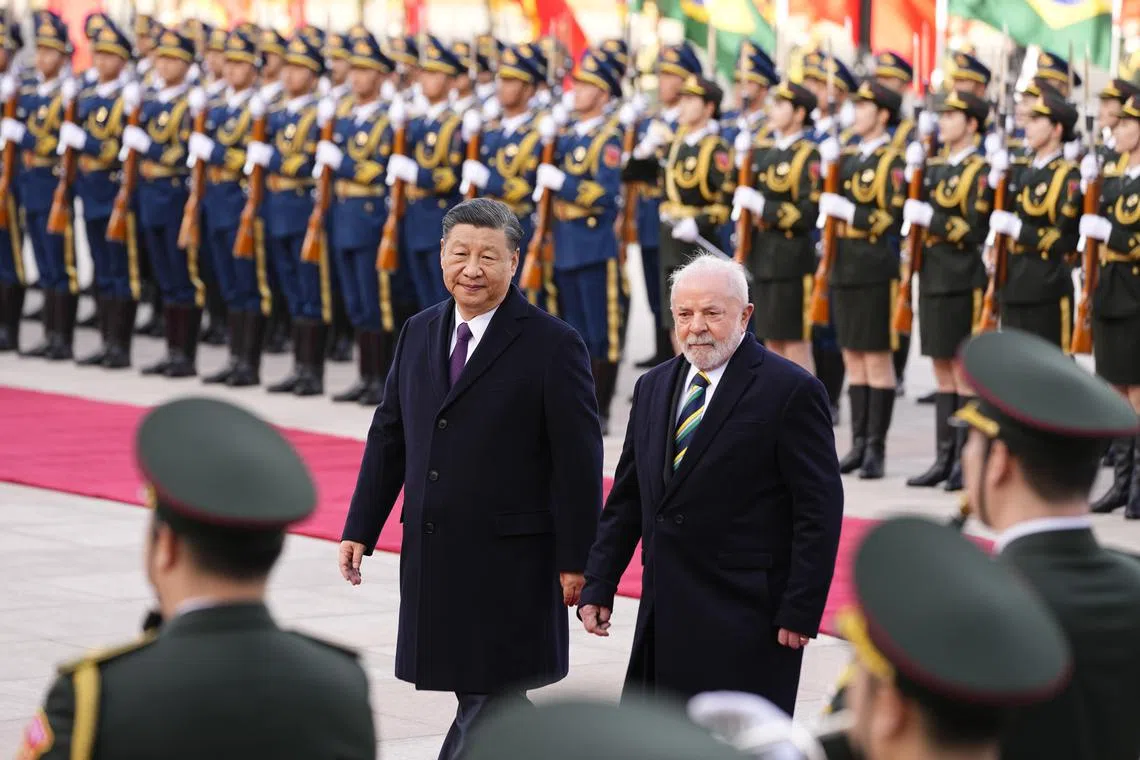China and Brazil deepen ties amid rising US-China tensions
Sign up now: Get ST's newsletters delivered to your inbox

Brazilian President Luiz Inacio Lula da Silva (right) with Chinese President Xi Jinping during a welcome ceremony outside the Great Hall of the People in Beijing, China, on April 14.
PHOTO: EPA-EFE
Follow topic:
BEIJING – Latin America’s biggest economy Brazil is moving closer to its largest trading partner China amid rising US-China tensions, with Chinese President Xi Jinping and Brazilian President Luiz Inacio Lula da Silva concluding their meeting on Friday with promises of deeper bilateral cooperation.
Both countries will work together in new areas such as the digital economy and fighting climate change.
The leaders also agreed to work even closer to strengthen cooperation in multilateral organisations such as the United Nations, the World Trade Organisation and the International Monetary Fund to give developing countries a bigger voice in global governance, according to a joint statement by China and Brazil on Friday.
Mr Lula’s four-day state visit,
He was supposed to visit China earlier in March but postponed his trip due to a bout of pneumonia.
China is Brazil’s largest trading partner, after overtaking the US in 2009. Their bilateral trade in 2022 reached US$171.5 billion (S$227.7 billion), a 4.9 per cent increase from 2021.
Analysts told The Straits Times that the warming ties between China and Brazil signal that Mr Lula is leaning towards China for economic support, after failing to get this from the US during his visit in February, and to help Brazil gain a louder voice in international affairs.
And China has welcomed Mr Lula, as closer ties between Brazil and China would allow Beijing to project influence in the Western hemisphere, where the US – its greatest rival – is, they added.
But Mr Lula will have to tread carefully to manage voters back at home, who still view China with suspicion, and Brazil’s ties with the US, said visiting professor at Beijing Foreign Affairs University Marcus Freitas.
The US announced its intent to contribute US$50 million to protect Brazil’s Amazon rainforest during Mr Lula’s visit. The reportedly disappointing figure was not enough to convince Mr Lula that he has the US’ support to boost Brazil’s economy, added Prof Freitas, an expert in Brazil-China relations.
“It was actually Chinese trade that allowed Brazil to navigate the 2007-2008 financial crisis in a much smoother way under the Lula administration,” Prof Freitas said.
He said the gains from the Brazil-China partnership could be “exponential”, especially if Chinese companies agree to invest in Brazil’s many infrastructure needs. “Lula is counting on the economic results to improve the country and win popular support.”
Mr Lula, who was Brazil’s two-term president between 2003 and 2011, made a comeback in October 2022 elections. He secured 50.9 per cent of the votes – a narrow political victory – against incumbent president Jair Bolsonaro. He started his third term on Jan 1, 2023.
One of Mr Lula’s objectives in visiting China is to reset bilateral ties, which had turned frosty under Mr Bolsonaro.
Mr Bolsonaro is a former far-right army captain who has been dubbed “Trump of the Tropics” due to the similar harsh stances he shared with former US president Donald Trump on thorny issues such as immigration. He portrayed China as a predatory economic power, famously denouncing Beijing as not just “buying in Brazil – but buying Brazil”.
Assistant Professor Benjamin Ho at the S. Rajaratnam School of International Studies in Singapore said China’s deeper ties with Brazil show Beijing’s confidence in projecting its influence “much farther than just its periphery”.
Prof Ho, who studies Chinese foreign policy and is the school’s China Programme coordinator, said: “More importantly, China might even want to send a signal to the US that it can project its influence as far as to the US’ side of the world.”
But Mr Lula has avoided framing the partnership with mainland China as representing opposition to the US, and he is likely to continue to seek stronger ties with both countries, S&P Global Market Intelligence analysts said in a note on April 6.
That Mr Lula did not sign a memorandum of understanding on China’s Belt and Road Initiative (BRI) during his visit to China is a sign of him treading carefully with voters back home, said Prof Freitas.
“Voters (in Brazil) still have the perception that Brazil should be closer to the US,” he added.
So far, there are 21 countries in Latin America in the BRI, with Argentina being the latest to join the infrastructure and investment development programme in 2022.
China’s state media has lauded Mr Lula’s state visit, with China Daily running an editorial on Friday saying that “bilateral cooperation between China and Brazil is deepening and their peoples are getting closer”.
S&P analysts said in the note that China regards Brazil as its largest and most important comprehensive strategic partner in Latin America and is likely to continue to pursue deepening economic and political ties with the Lula government during President Xi’s third term.
“China-Brazil relations are likely to remain a key component of President Xi’s foreign policy, which has emphasised securing trade routes and building strategic alliances with emerging economies through signature initiatives such as the BRI,” they added.
Mr Lula started his visit in Shanghai on Wednesday, where he visited Chinese telco giant Huawei’s technology centre and the New Development Bank (NDB), before he met Mr Xi in the capital city Beijing on Friday. NDB was founded by Brics, a grouping of major developing countries whose members are Brazil, Russia, India, China and South Africa.
Mr Lula also met Premier Li Qiang and Mr Zhao Leji, chairman of the country’s top legislature and third-ranking member of the Politburo Standing Committee, China’s apex of power, during his visit.


